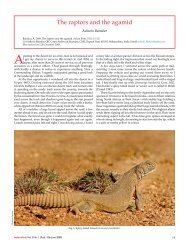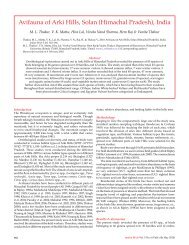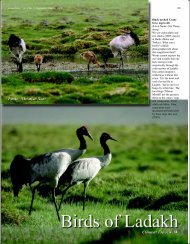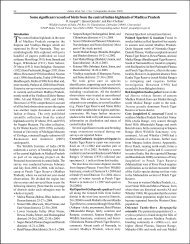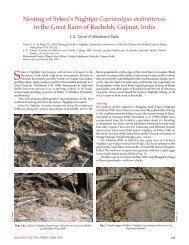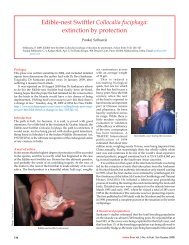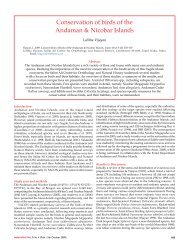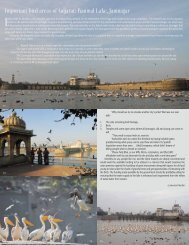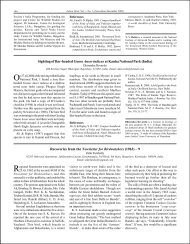Birding adventures in Kachchh, Gujarat - Indian Birds
Birding adventures in Kachchh, Gujarat - Indian Birds
Birding adventures in Kachchh, Gujarat - Indian Birds
You also want an ePaper? Increase the reach of your titles
YUMPU automatically turns print PDFs into web optimized ePapers that Google loves.
Sreenivasan: <strong>Bird<strong>in</strong>g</strong> <strong>in</strong> <strong>Kachchh</strong> 103<br />
Photos: Ramki Sreenivasan<br />
th<strong>in</strong>g told me that this thunderstorm was go<strong>in</strong>g to be one that I<br />
would not forget <strong>in</strong> a hurry.<br />
For the next two hours, we held on dearly to whatever support<br />
we could f<strong>in</strong>d <strong>in</strong>side the jeep, while Lakkubhai kept his foot<br />
on the recalcitrant accelerator. It was one of the f<strong>in</strong>est displays of<br />
cross-country driv<strong>in</strong>g I’ve ever had the privilege to witness. Even<br />
a moment’s lapse <strong>in</strong> concentration would have caused the tyres<br />
to s<strong>in</strong>k <strong>in</strong>to the th<strong>in</strong> top-layered soil, so notorious for harbour<strong>in</strong>g<br />
quicksand. And when we f<strong>in</strong>ally hit the road, the ‘high-fives’ were<br />
born more out of relief than jubilation.<br />
<strong>Kachchh</strong> (earlier referred to as Kutch, and sometimes, Cutch)<br />
is a mysterious land, not easy to comprehend. Much of its area<br />
cannot easily be covered, and it is larger <strong>in</strong> size than some states<br />
of India. Spread over 45,612 km 2 , a quarter of <strong>Gujarat</strong>’s landmass,<br />
<strong>Kachchh</strong> is the second largest district <strong>in</strong> the country after<br />
Ladakh. More than half of it consists of sal<strong>in</strong>e marshes of the<br />
Great-, and Little Rann, which bound the district on the north<br />
and east, virtually mak<strong>in</strong>g <strong>Kachchh</strong> an island—the other sides are<br />
marked by the Arabian Sea and the Gulf of <strong>Kachchh</strong>. The border<br />
with Pakistan lies along the northern edge of the Great Rann.<br />
<strong>Kachchh</strong> literally means a place which is <strong>in</strong>termittently wet<br />
and dry, as a large part of this district is shallow wetland, which<br />
submerges dur<strong>in</strong>g the ra<strong>in</strong>y season and becomes dry dur<strong>in</strong>g the<br />
rest of the year. This makes the terra<strong>in</strong> extremely treacherous,<br />
and the absence of obvious landmarks does not help either, as<br />
you wend your way through desolate patches.<br />
I travel, as a part of my passion for photograph<strong>in</strong>g all sorts of<br />
<strong>Indian</strong> birds, to various hotspots <strong>in</strong> the country. <strong>Bird<strong>in</strong>g</strong>, by its very<br />
nature, makes one an <strong>in</strong>trepid traveller as it necessitates voyages<br />
to the remote. There existed a famous argument <strong>in</strong> the early<br />
decades after <strong>in</strong>dependence as to who was better travelled <strong>in</strong><br />
India—Prime M<strong>in</strong>ister Jawaharlal Nehru or the ornithologist, Salim<br />
Ali. I don’t th<strong>in</strong>k Panditji even came a close second!<br />
Of all the <strong>Indian</strong> Subcont<strong>in</strong>ent’s bird-rich regions, it is the arid<br />
northwest, and <strong>Kachchh</strong> <strong>in</strong> particular, that hold one of the greatest<br />
diversity of avian species. This is because of the unique and<br />
spectacular habitats <strong>Kachchh</strong> supports. The bird-list is close to<br />
400 species and the focus of my expeditions was to photograph<br />
some important residents, as well migrants, that come from the<br />
Middle East, and various parts of Europe. I have now made four<br />
trips to this part of the world, <strong>in</strong>clud<strong>in</strong>g the Wild Ass Sanctuary <strong>in</strong><br />
the Little Rann, which despite its related name, doesn’t lie <strong>in</strong> the<br />
district of <strong>Kachchh</strong>.<br />
Our patch of magic falls on the migratory route of palaearctic<br />
birds. A stream of migrants passes through every year, start<strong>in</strong>g<br />
Camels <strong>in</strong> Banni<br />
Desert cat Felis sylvestris<br />
from August and cont<strong>in</strong>ues till end of March. The vast open areas<br />
and low-ly<strong>in</strong>g flood-pla<strong>in</strong>s of Banni and Great Rann together with<br />
the man-made wetlands, dams, reservoirs, ponds and lakes provide<br />
excellent habitat for waders, waterfowl, and cranes.<br />
As mentioned earlier, <strong>Kachchh</strong> is a huge area and it can easily<br />
swallow any number of trip days, or weeks. Hence absolute focus<br />
and rigorous plann<strong>in</strong>g are critical to tackle your trip. For me the task<br />
was straightforward—divide the area by habitat, thereby target<strong>in</strong>g<br />
birds unique to specific environments. In this way I covered both<br />
the Ranns, as well as the semi-desert, grasslands, wetlands, coast,<br />
and tropical thorn forest. The diverse habitats support an assortment<br />
of specialty birds, <strong>in</strong>clud<strong>in</strong>g rare and threatened species.<br />
Some of these <strong>in</strong>clude Great <strong>Indian</strong> Bustard Ardeotis nigriceps,<br />
Lesser Florican Sypheotides <strong>in</strong>dica, White-naped Tit Parus<br />
nuchalis, Marshall’s Iora Aegith<strong>in</strong>a nigrolutea, White-bellied M<strong>in</strong>ivet<br />
Pericrocotus divaricatus, Cream-coloured- Cursorius cursor<br />
and <strong>Indian</strong> C. coromandelicus Courser, Greater- Phoenicopterus<br />
ruber and Lesser- P. m<strong>in</strong>or Flam<strong>in</strong>gos, Sarus Grus antigone, Common-<br />
G. grus and Demoiselle- G. virgo Cranes. Fourteen different<br />
species of larks (Fam: Alaudidae), <strong>in</strong>clud<strong>in</strong>g Greater Hoopoe-Lark<br />
Alaemon alaudipes dot the landscape. Innumerable raptors too<br />
are present.<br />
Summer (passage) migrants that typically come from the<br />
Middle East and Africa <strong>in</strong>clude Spotted Flycatcher Muscicapa striata,<br />
European Nightjar Caprimulgus europaeus, European Roller<br />
Coracias garrulus, Greater Whitethroat Sylvia communis, Rufoustailed<br />
Scrub-Rob<strong>in</strong> Cercotrichas galactotes, and Blue-cheeked<br />
Bee-eater Merops persicus.<br />
W<strong>in</strong>ter migrants <strong>in</strong>clude Houbara Bustard Chlamydotys houbara,<br />
Grey Hypocolius Hypocolius ampel<strong>in</strong>us, and several raptors,<br />
not to mention the esoteric and little-known Stoliczka’s Bushchat<br />
Saxicola macrorhyncha, four types of wheaters (Oenanthe spp.),<br />
Common Crane (upto 40,000), and several speciality waders<br />
like Crab-Plover Dromas ardeola, and Eurasian Oystercatcher<br />
Haematopus ostralegus.<br />
In addition to avian diversity, <strong>Kachchh</strong> also supports a host of<br />
mammals like the wolf Canis lupus, golden jackal C. aureus, desert-<br />
Vulpes v. pusilla and <strong>Indian</strong>- C. vulpes bengalensis fox, desert-<br />
Felis sylvestris and jungle- F. chaus cat, <strong>Indian</strong> gazelle Gazella<br />
bennettii, blackbuck Antilope cervicapra, Asiatic wild ass Equus<br />
hemionus and the nilgai Boselaphus tragocamelus. Sp<strong>in</strong>y-tailed-<br />
Uromastyx hardwickii and monitor- Varanus bengalensis lizards<br />
make up the bulk of the reptilian population. With a lot of detailed<br />
plann<strong>in</strong>g, local expertise, and a dollop of Lady Luck, it is possible<br />
to see most of these animals and birds. Given the accessible flat



